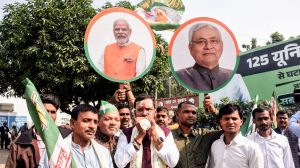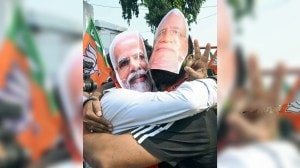In Black and White
Doubts could have been addressed,not dismissed as myths
Book: Indias Tryst with Destiny
Author: Jagdish Bhagwati and Arvind Panagariya
Publisher: Collins Business
Price: Rs 599
Pages: 304
This volume,by two celebrated and regular commentators on the Indian economy,is a straight-from-the-heart defence of the post-1991 liberalisation and reforms of the Indian economy. The first part of the book rebuts various criticisms of the reform process,termed by the authors as myths. The second and third parts of the book outline suggestions for deepening and expanding the reforms process,in sections dealing with Track II and Track III reforms.
Substantively,the book reiterates the authors familiar suspicion of government,their irrepressibly optimistic belief in the invisible hand and their loyalty to laissez faire. Simply written,the book is a quick read,and therein lies the rub. If one were to start from Nehrus vision for independent India (which somewhat surprisingly is reviewed favourably by the authors),go on to a reasoned assessment of which parts of that vision worked and which failed (and why),link that assessment with factors that prompted the need for reforms,and then evaluate the post-reform experience,it would lead to an academic enquiry which would not only be long and complex,but,ideally,would also have plenty of shades of grey. This volume attempts a giant sweep of all these issues,but presents us with blocks of black (the myths) and white (the rebuttal,i.e.,the rosy face of reforms).
In setting up these black-and-white blocks,the authors end up making two critical omissions,which are not only surprising for a book written in 2012,but also put their whole argument under a cloud. First,there is no mention of the growth slowdown of the Indian economy. The growth recorded in 2012-13 is the slowest in the last decade. And this slowdown started at least two years back,if not earlier. Reading this book,we wouldnt know that. And,if growth itself is slowing down,what would be the fate of the supposedly virtuous cycle of reforms leading to higher growth,leading to a bigger pie,so that everyone gets more? According to the book,this is not simply a chimera this is what actually happened between 1991 and the present.
That brings us to the second omission. There is no mention of the various social movements in India precisely during the era of high growth. If gains from high growth were,in fact,equitably distributed across regions,castes,communities,what were the causes of the multiple instances of discontent? Maybe these agitations are not directly related to the state of the economy (that would have to be proven,not assumed); but if discontent exists despite high growth,it indicates that the recipe for social stability,critical to sustain growth,is more complicated than meets the eye. More generally,the authors firm belief in the trickle-down theory borders on the innocent. Forget about India; there hasnt been much trickle-down even in the advanced industrial countries,where markets work far better,but not smoothly enough to prevent substantial inequalities and widespread social discontent.
It is also hard to be persuaded by the authors representation of the dark side. This comprises an unbelievably diverse and heterogeneous set of institutions and individuals,ranging from the World Bank and UNDP,to scholars and activists such as Amartya Sen,Dani Rodrik,Arvind Subramaniam,Jean Dreze,Vandana Shiva etc. all the way to Himanshu of JNU,and media outfits such as the NDTV. These individuals and institutions have very distinct sets of beliefs,with several not conventionally viewed as anti-reforms at all. The basis of this omnibus clubbing under the anti-reform umbrella is often flimsy e.g. a story on malnutrition or farmer suicides by NDTV pushes it in the large dustbin of antiquated beliefs whereas most of us would not view such stories (which incidentally all media outlets run occasionally) as representing any deep commitment to an anti-reform ideology.
The book does raise several important issues that are actively being debated in policy circles (cash transfers versus PDS,the rigidity of labour laws,etc.). However,the treatment of these issues ranges from patchy to simple. The authors present no evidence (which exists in academic research) that goes behind the myths. That is easy to understand,for if the evidence were presented,these could no longer be termed myths. What is harder to understand is that there is very select evidence in support of the main argument,which is sometimes just anecdotal. If overwhelming evidence shows that reforms produce high growth that trickles down to all sections efficiently,why not summarise all of it,with details in the bibliography?
In the context of malnutrition of children,the Asian enigma is a well-known conundrum Indian children tend to be shorter than children in the far poorer countries of sub-Saharan Africa. And this is not due to genetics children who move from India to richer countries in early life are not stunted. Some of the explanatory factors are the differences in the disease environment and rural sanitation between the two regions (which includes access to toilets),and living with inequality (e.g. womens social rank matters for child height). But evidence in support of the other side is not only absent,the enigma itself is classified as a myth.
Similarly,while the actual data on the catch-up of Dalits and Adivasis with the upper castes shows,at best,a mixed picture,the book argues that reforms have led to convergence. While there has been convergence in the areas of primary and possibly middle school education,there is continued divergence in higher education and labour market outcomes. The very welcome formation of the Dalit Indian Chamber of Commerce and Industry,and the consequent focus on a few Dalit millionaires,cannot divert attention from the fact that most Dalit businesses are survival-level,low-productivity entities.
The ultimate proof of the pudding is in the eating. If the reforms-growth-everyone-grows-richer-more-reforms story is true,it will show,and the myth-makers will be buried under the sheer weight of evidence. But we are not there yet,and the jury is out on each of the links of the supposed virtuous cycle. Until then,doubts and questions will remain,and would need to be answered,not dismissed as myths.
Ashwini Deshpande is professor at the Delhi School of Economics


- 01
- 02
- 03
- 04
- 05





























